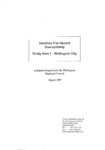Interface Fire Hazard Susceptibility Wellington City
Search in document library
Purpose of the report to identify areas in Wellington City where vegetation and terrain pose a heightened risk of wildfire at the rural-urban interface.
Geographic Area Covered
This report covers Wellington City, including suburbs such as Island Bay, Karori, Brooklyn, Strathmore, Wadestown, Newlands, and Linden, focusing on the rural-urban interface zones.
Summary of Key Findings
This report assesses wildfire hazard susceptibility in Wellington City’s rural-urban interface. It identifies vegetation types, terrain, and climatic factors that contribute to fire risk. The hazard model used considers vegetation type, slope, aspect, rainfall, and proximity to people. Vegetation such as gorse, rank grass, and young pine are classified as extreme fire hazards. North-facing slopes and areas with low rainfall are more susceptible to drying and fire spread. The report maps hazard zones and highlights areas with high fire risk including Island Bay, Owhiro Bay, Karori, Brooklyn, Strathmore, Wadestown, and parts of Newlands and Linden. Defensible space—areas with reduced fuel near buildings—is emphasized as a key mitigation strategy. Recommendations include managing vegetation to reduce flammability, increasing defensible space around buildings, and adapting building design and materials to suit hazard levels. For new developments, siting and setbacks should reflect local fire hazard conditions. The report suggests prioritizing mitigation efforts in high hazard zones and educating residents on practical steps to reduce risk. It also notes that mapping within urban areas should be done at a finer scale to accurately assess vegetation and defensible space around individual buildings.